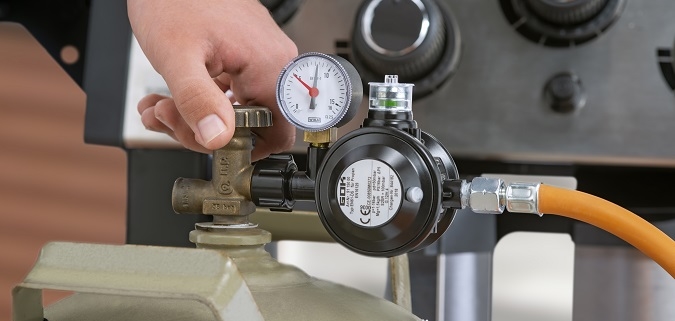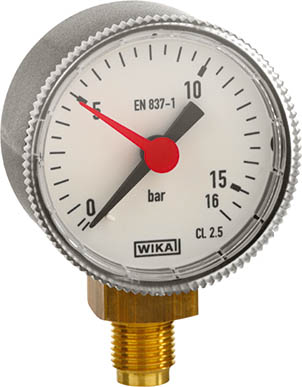How do I check a system with the pressure regulator pressure gauge for leak-tightness?
Some people incorrectly view the pressure gauge on the pressure regulator as a gas cylinder filling level indicator. But it definitely isn’t. First and foremost, it is intended to reliably indicate the pressure present in the gas cylinder. If the pressure gauge has two pointers, a black one and a red one, the user can also make using their LPG system safe very easily and quickly.
Quickly checking the entire system for leaks without high-quality technical equipment in an absolutely straightforward manner, and while doing something else in the meantime. Does this sound unrealistic? But it’s true, thanks to a pressure gauge integrated into the pressure regulator. We’re going to do this in the following scenario:
Example scenario
The garden party is in full swing, however the sun has gone down and it will become considerably chillier in the next hour. While the host is still grilling the last steaks on the gas barbecue, his wife is already connecting the gas cylinder to the patio heater.
Leak test with pressure gauge and red pointer
With a maximum of three additional movements, she checks for leaks in the entire LPG system at the patio heater and can still eat her steak in the meantime. We show you exactly how it works:
- Close all shut-off fittings on the patio heater
- Slowly open the valve on the gas cylinder
- Turn the inspection glass of the pressure gauge with the printed red pointer to the exact same position as the black pointer. The black pointer marks the actual pressure
- Close the gas cylinder valve again and wait for two minutes to allow any temperature equalisation to take place ⇒ Use the time to load your plate with steak and salad
- If necessary, adjust the red pointer to the changed position of the black pointer
- Then keep the test time of ten minutes ⇒ Use the time to enjoy your food
Black and red pointer?
We may have to explain one or two things in a little more detail. On 3: The pressure gauge has a black pointer which shows the actual pressure in the gas cylinder. The red pointer, on the other hand, can be changed manually, as it is printed on the pressure gauge inspection glass. It can be rotated to the exact same position as the black pointer.
On 4:
The LPG is now enclosed in the system to a certain degree. However, due to the ambient temperature or strong sunlight, you should wait for two minutes to allow the temperature equalisation in the gas to take place.
Larger deviation? Leak detection!
If, within these two minutes, the black pointer drifts away from the red pointer due to temperature differences, simply return the red pointer to the position of the black one (on 5).
If the red and black pointers are still in the same position after ten minutes, the system is completely sealed and ready for use. In case of a larger deviation, you should repeat the leak check or look for the leaky connection directly using leak detector spray.
Leak check with pressure gauge without red pointer
Incidentally, the LPG system can also be checked for leaks if the pressure gauge only has a black pointer:
- Close all shut-off fittings on the patio heater
- Slowly open the valve on the gas cylinder
- Manually mark the position of the black pointer (display of the current cylinder pressure)
- Close the gas cylinder valve again and wait for two minutes to allow any temperature equalisation to take place
- If necessary, adjust the manual marking to the changed position of the black pointer
- Then adhere to the test time of ten minutes






